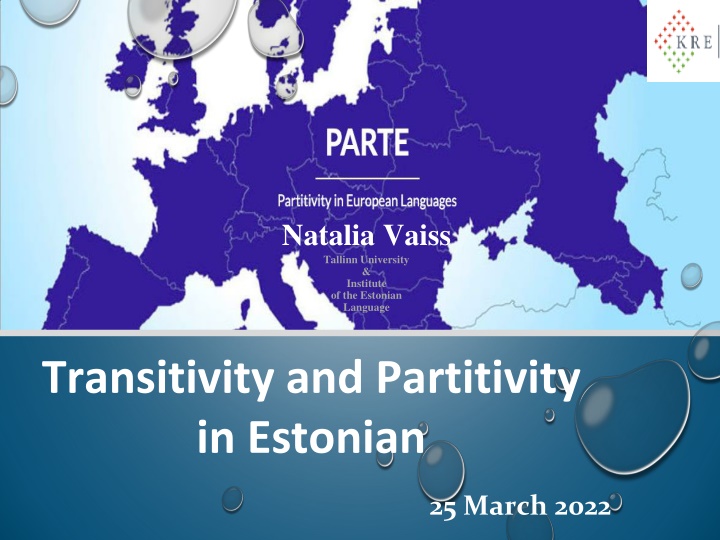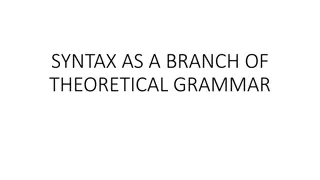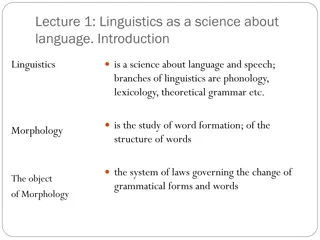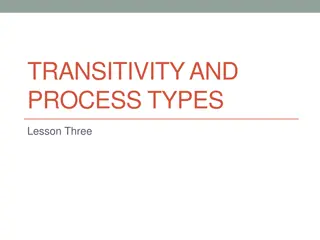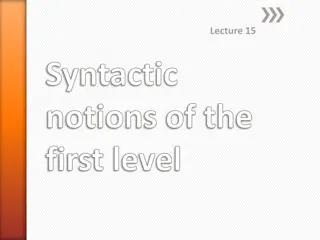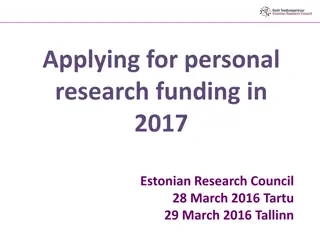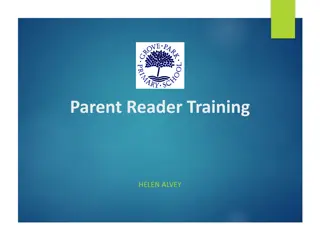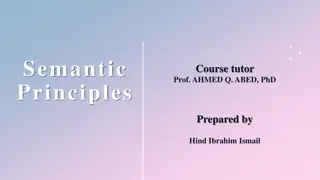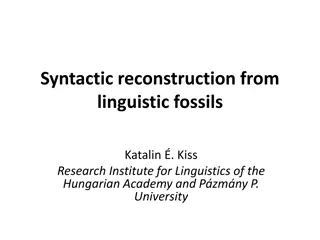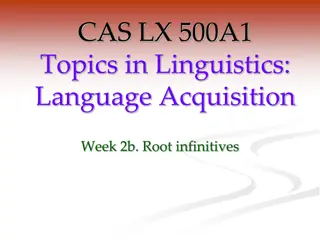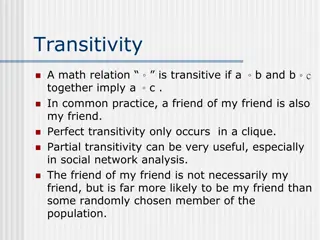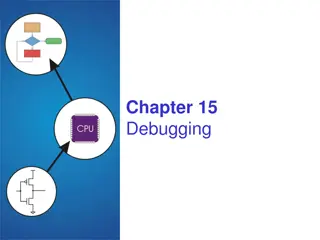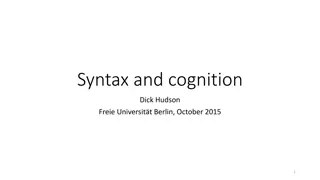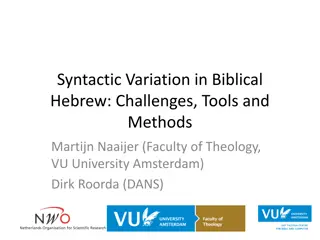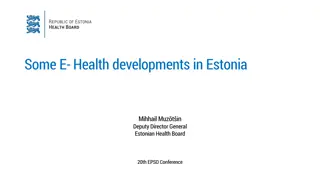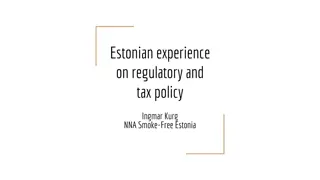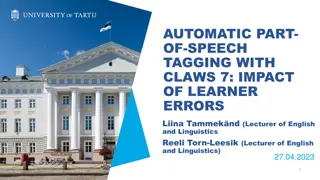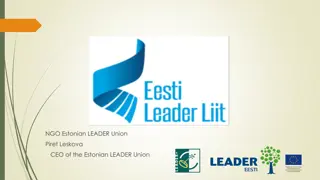Syntactic Transitivity in Estonian Language
This presentation by Natalia Vaiss from Tallinn University delves into the intricate details of syntactic transitivity types and the usage of direct objects, particularly focusing on partitive-accusative alternations in the Estonian language. It explores the morphological aspects of genitive and nominative cases as accusative, and discusses formal and functional-semantic approaches to transitivity. The key concepts of functional-semantic transitivity, parameters of transitivity, and syntactic transitivity are elucidated, shedding light on the nuanced aspects of language structure and usage.
Download Presentation

Please find below an Image/Link to download the presentation.
The content on the website is provided AS IS for your information and personal use only. It may not be sold, licensed, or shared on other websites without obtaining consent from the author.If you encounter any issues during the download, it is possible that the publisher has removed the file from their server.
You are allowed to download the files provided on this website for personal or commercial use, subject to the condition that they are used lawfully. All files are the property of their respective owners.
The content on the website is provided AS IS for your information and personal use only. It may not be sold, licensed, or shared on other websites without obtaining consent from the author.
E N D
Presentation Transcript
Natalia Vaiss Tallinn University & Institute of the Estonian Language Transitivity and Partitivity in Estonian 25 March 2022
THE PRESENTATION AIMS to offer an overview of syntactic transitivity types usage of direct objects (partitive-accusative alternations) in Estonian *the morphological genitive/ nominative as the cases of direct objects named here together as accusative
APPROACHES TO TRANSITIVITY SYNTACTIC (FORMAL) FUNCTIONAL-SEMANTIC COMBINATIONS OF SYNTACTIC & SEMANTIC APPROACHES (for more details see Kittil 2010)
FUNCTIONAL-SEMANTIC TRANSITIVITY The key issue is the notion of the basic transitive event, which involves a volitional and controlling agent and an affected patient. That is, if the subject is less agentive and/ or if the object is less affected, then the transitivity of the clause is lower. COMPARE: o The man startled me. > The picture startled me. o I drank up the milk. > I drank some of the milk. > I like the milk.
PARAMETERS OF TRANSITIVITY (Hopper & Thompson 1980) *each parameter suggests a scale according to which clauses can be ranked HIGH TRANSITIVITY LOW TRANSITIVITY PARTICIPANTS 2 > (A & O) action telic punctual volitional affirmative realis high agency totally affected 1 non-action atelic non-punctional non-volitional negative irrealis low agency not affected KINESIS ASPECT PUNCTUALITY VOLITIONALITY AFFIRMATION MODE AGENCY AFFECTEDNESS OF OBJECT INDIVIDUATION OF OBJECT highly individuated non-individuated
SYNTACTIC TRANSITIVITY The number and the marking of arguments are central questions in formal approaches. Based on the occurrence of direct objects, verbs in most languages fall into at least three categories (Dixon & Aikhenvald 2000: 12 13): 1) intransitive (do not occur with direct objects), 2) transitive (generally occur with direct objects), 3) ambitransitive or labile (with or without a direct object). The subtypes of these categories may vary from language to language.
MAIN FEATURES OF TRANSITIVITY IN ESTONIAN THE REGULARITY OF COGNATE AND FAKE OBJECTS (see Kont 1963, Tamm 2012). THE PRESENCE OF PARALLEL VERB PATTERNS, WITH AND WITHOUT A DIRECT OBJECT (see R tsep 1978, Metslang 2017) FREQUENT LABILITY (see Letuchiy 2013, Kehayov & Vihman 2014) OBJECT OMISSION WITH ALMOST ANY VERB but to different extent depending on a verbal type and context (Metslang 2017).
COGNATE AND FAKE OBJECTS a widespread transitivizing mechanism in Estonian Lase mu-l kohtu-da oma kohtumisi. Let.IMP I-ADE meet-INF own meeting.PAR.PL Let me meet with people I want/ need to meet *Literal translation into English or Russian is not grammatical.
COGNATE AND FAKE OBJECTS (2) Poiss sai kukku-da oma kukkumise-d. boy.NOM could fall-INF own falling-ACC.PL The boy could fall down as many times as he wanted Issi, ma vist kukku-si-n pesuresti k vera-ks. daddy I probably fall-PST-1SG laundry_chut.ACC bent-TRA Daddy, I think I fell down on the laundry chut, and it bent. Libeda-te-l t nava-te-l kukku-s end vigase-ks palju inimesi. slippery-PL-ADE street-PL-ADE fall-PST-3SG self.PAR injured-TRA many people.PAR.PL On slippery streets, many people fell and injured themselves.
COGNATE AND FAKE OBJECTS (3) h ppa-s k rgus-t / kaugus-t. T druk girl.NOM.SG jump-PST.3SG high _/ long _jump-PAR The girl was jumping / jumped a high / long jump h ppa-s oma h pe-t / oma h ppe ra. T druk girl.NOM.sg jump-PST.3SG own jump-PAR/.ACC prt The girl was jumping / jumped her jump h ppa-s raamatu lapiku-ks. T druk girl.NOM.sg jump-PST.3SG book.ACC flat-TRA The girl jumped on the book until it was flat
PARALLEL VERB PATTERNS, WITH AND WITHOUT A DIRECT OBJECT Ta alusta-b treening-uid/ treeningu-te-ga s/he.NOM start-PRS.3SG training-PAR.PL/-PL-COMIT S/he starts training. Ta vaata-b merd/ mere-le s/he.NOM look-PRS.3SG sea-PAR/-ALL S/he looks at the sea .
FREQUENT LABILITY (for prototypical lability see more Letuchiy 2013) ! There are over 90 labile verbs in Estonian (Kehayov & Vihman 2014), as compared to, for example, over 800 labile verbs in English (McMillion 2006) and ca 30 labile verbs in Russian (Letuchiy 2006). There are 4 types of prototypical lability in Estonian (Kehayov & Vihman 2014): patient-preserving agent-preserving reflexive reciprocal
PATIENT-PRESERVING LABILITY (at least 54 verbs in Estonian) a. Poiss boy.NOM The boy sprays water. b. Vesi water.NOM The water sprays (out). (Kehayov & Vihman 2014: 1070) pritsi-b spray-PRS.3SG vett. water.PAR pritsi-b. spray-PRS.3SG
AGENT-PRESERVING LABILITY (at least 19 verbs in Estonian) a. J ri jaluta-s walk-PST.3SG koera. dog.PAR J ri.NOM J ri walked the dog. b. J ri J ri.NOM J ri walked. (Kehayov & Vihman 2014: 1070-1071) jaluta-s. walk-PST.3SG
REFLEXIVE LABILITY (at least 12 verbs in Estonian) a. J ri siruta-s k si. J ri.NOM stretch-PST.3SG hand.PAR.PL J ri stretched his hands. b. J ri siruta-s J ri.NOM stretch-PST.3SG and stand_up- PST.3SG J ri stretched and stood up. (Kehayov & Vihman 2014: 1073) ja t usi-s.
RECIPROCAL LABILITY (at least 8 verbs in Estonian) a. J ri kallista-s embrace-PST.3SG Mari-PAR Mari-t. J ri.NOM J ri embraced Mari. b. J ri J ri.NOM J ri and Mari embraced. (Kehayov & Vihman 2014: 1073) ja and Mari Mari.NOM embrace-PST.3PL kallista-sid.
POLYSEMIC LABILITY (see Vaiss 2021) Abielu marriage.ACC The marriage was divorced. Abielupaar married_couple.NOM A married couple divorced. Kirik church.ACC The church was separated from the state. Lahuta-ge subtract-IMP.2PL Subtract two from five. Lahuta-ge entertain-IMP.2PL Entertain yourself. Ta lahuta-s s/he.NOM shrug-PST.3SG S/he shrugged. lahuta-ti. divorce-IPS.PST lahuta-s. divorce-PST.3SG lahuta-ti separate-IPS.PST riigi-st. state-ELA viie-st five-ELA two.ACC kaks. meelt. mind.PAR k si. hand.PAR.PL
OBJECT OMISSION (= null objects/ object deletion, or object drop; see Luraghi 2004, Onozuka 2007) is possible with almost any verb but to different extent depending on a verbal type and context (Metslang 2017). COMPARE: T tar s -b daughter.NOM eat-PRS.3SG The daughter is eating [ ] in her room Alusta-si-me nulli-st. start-PST-1PL null-ELA We started [ ] from scratch. (a fixed expression with an omitted object) Ta alusta-b pingu-te-ga. s/he.NOM start-PRS.3SG studying-PL-COMIT S/he starts studying. (a parallel verb frame pattern with the comitative or an omitted object) P hjustab k ll. cause-PRS.3SG indeed (as the answer to the question Does this cause a problem? Yes, [this] does cause [an omitted object: a problem]) oma own toa-s. room-ELA
TRANSITIVITY CONTINUUM IN ESTONIAN (Vaiss 2021) 1) strictly intransitive verbs (e.g., sulama melt , n ustuma agree , tutvuma get acquanted , loobuma refuse , hinema join ) 2) generally intransitive verbs used transitively with cognate and fake objects (e.g., kukkuma fall , magama sleep , jooksma run , also tantsima? dance , laulma? sing ) 3) prototypically labile (e.g.,) jalutama walk , p rama turn , r mustama delight , suudlema kiss , & polysemic labile verbs (e.g., lahutama divorce ; separate , divide ; deduct , subtract , also m ngima? play ) 4) transitive verbs used as intransitives with the focus on activity (e.g., s ma eat , koristama clean , kirjutama write , mblema sew , also harjutama? practice ) 5) generally transitive verbs used without a direct object in fixed expressions/ meanings or parallel verb frame patterns (e.g., alustama start , j tkama continue , l petama finish , also jooma? drink , n gema? see ) 6) strictly transitive verbs used with omitted objects in highly restricted syntactical patterns (e.g., eeldama assume , sisaldama contain , p hjustama cause , moodustama constitute , also omama? have )
TRANSITIVITY CONTINUUM (2) The hypothesis of continuum summarizes the previous findings of research on transitivity in Estonian and it is proved by analysis based on the 2019 Estonian National Corpus. Based on previous sources, for every group, five representative verbs have been selected and their transitivity measure has been controlled by using Sketch Engine software. For each verb, the first 500 results (using the Shuffle function) have been analyzed.
TRANSITIVITY CONTINUUM (3) The analysis proved that there are verbs in Estonian that match the groups 1-6 very well. However, there are also verbs that are in between two or more groups (natural for a continuum). The most stable are categories 1, 2 and 6. We might confirm that there are indeed two groups of intransitive verbs in Estonian and also the group of strictly transitive verbs. The most fuzzy is the third group (prototypically labile & polysemic labile verbs) as polysemy is very common to Estonian verbs. Groups 3-5 represent different kinds of ambitransitivity in Estonian. Further research may reveal other possible intermediate cases.
MNGIMA PLAY as an example of ambitransitivity due to polysemy Patient-preserving lability: DJ DJ.NOM The DJ plays music m ngi-b play-PRS.3SG muusika-t. music-PAR Muusika music.NOM The music is playing m ngi-b. play-PRS.3SG Focus on activity: Lapse-d child-NOM.PL Children play in their room m ngi-vad play-PRS.3SG oma own toa-s. room-ELA (Regular) omitted objects: Viiulim ngija/ N itleja violinist.NOM/ actor.NOM A violinist/ An actor plays well/ skillfully m ngi-b play-PRS.3SG oskuslikult. skillfully J ri J ri.NOM play-PRS.3SG J ri played as an attacker for about 3-4 years m ngis r ndaja-na attacker-ESI umbes about 3-4 three-four year-PAR aasta-t.
Groups 1-6 with direct objects among 500 corpus sentences (Vaiss 2021) 1 2 3 4 5 6 Occured with a direct object among 500 corpus sentences 0 1-35 3-83 57-71 57-87 97-100
Main features of groups 1-6 (Vaiss 2021) 1 2 3 4 5 6 Cognate and fake objects - ++ + + + - Definite object omission - + + + ++ + Indefinite object omission - - + ++ + + Verb pattern without a direct object ++ - + + ++ - Verbal polysemy - + ++ + + + Highly agentive subject + ++ + + + + - does not occur, + occurs, ++ occurs regularly
Transitivity in Estonian is realized by partitive or accusative direct objects Differential object marking: TOTAL/ ACCUSATIVE OBJECT PERFECTIVE/ BOUNDED EVENT PARTITIVE OBJECT IMPERFECTIVE/ UNBOUNDED EVENT BUT the object case distinguishes aspect in an affirmative sentence with a quantitatively bounded object and mostly for aspect and perfective verbs, and only to some extent for partitive verbs. *Aspect is also expressed by context, tense, perfective particles or other bounding elements.
Estonian verbs aspectual classification (Metslang 2017) imperfective verbs express unbounded durative events or states (e.g. intransitive verbs elama live , asuma be located , transitive partitive verbs armastama love , huvitama interest ) perfective verbs express bounded momentous events (e.g. intransitive verbs plahvatama explode , lahkuma leave , transitive perfective verbs andestama forgive , saavutama achieve ) imperfective-perfective verbs express events that might be bounded (mostly transitive aspect verbs, e.g. verbs ehitama built , kirjutama write , but also some intransitive verbs kasvama grow , v henema decrease )
DIRECT OBJECTS IN PARTITIVE In Estonian, as in Finnish (Huumo 2010, Luraghi & Kittil 2014, Larjavaara 2019), a partitive direct object occurs in the following cases: o 1) negation (e.g., Ta ei l petanud lesannet S/he did not finish the task.PAR ), o 2) indefinitness of an object or its quantity (e.g., Ta ostis juustu S/he bought (some) cheese.PAR ), o 3) imperfective aspect (e.g., Ta v rvis p randat S/he colored the floor.PAR ), o 4) a partitive verb (e.g., T druk aitas s pra The girl helped her friend.PAR ), o 5) some special cases in Estonian grammar (e.g., personal pronouns (the 1st and 2nd person), a neutral aspect, an object of an infinitive form etc.) (see Metslang 2017).
DIRECT OBJECTS IN PARTITIVE (2) In addition, a partitive direct object may (see Vaiss 2020) o 1) reflect a distinction in meaning Vargad r visid meest A man.PAR was robbed by thieves Terroristid r visid mehe A man.ACC was kidnapped by terrorists o 2) be a part of an idiomatic phrase Autojuht pani pidurit The driver hit the brakes.PAR , o 3) depend on the lexical nature of an object phrase Hotell aktsepteeris minu krediitkaarti The hotel accepted my credit card.PART Komisjon aktsepteeris ettepanekut/ ettepaneku The commission was accepting the proposal.PAR/ The commission accepted the proposal.ACC
SCALE OF PERFECTIVITY/PARTITIVITY OF ESTONIAN VERBS (groups 2-6) hard partitive verbs (e.g., eelistama prefer , armastama love ) soft or weak partitive verbs (e.g., lugema read , veeretama roll ) aspect verbs (e.g., ehitama build ) perfective verbs (e.g., l bi lugema read through , leidma find )
PARTITIVE VERBS = low transitivity verbs (Luraghi & Kittil 2014) semantically very heterogeneous: mostly state verbs that express feelings (nt armastama love , vihkama hate ), relationships (nt usaldama trust , uskuma believe ), desire or need (nt tahtma want , vajama need ) etc, but also action verbs like n gema see , kuulama listen , katsuma touch , maitsma taste , vaatama watch , aitama help , alustama start , m ngima play , t nama thank , nnitlema congratulate , ppima learn , llatama suprise , pildistama take a photo , tervitama greet , tutvustama introduce etc
PARTITIVE VERBS may also denote perfective events: Ma tervita-si-n I.NOM greet-PST-1SG I was greeting/ greeted the neighbour naabri-t. neighbour-PAR are heterogeneous also syntactically: HARD and SOFT partitive verbs (see Klaas 1999)
The scale of partitive verbs (Tamm & Vaiss 2019: 160) Subgroup Type Example 1 a Genuinely hard partitive verbs eelistama prefer , armastama love 1 b Hard partitive verbs that form another lexical item with a lexicalized boundary element tundma know, feel / ra tundma recognize 2 a Framed soft partitive verbs ihuma sharpen , harjutama practice , aitama help , veeretama roll 2 b Contextual soft partitive verbs ppima learn , vaatama watch , lugema read
HARD PARTITIVE VERBS (1a) Total objects are not possible Eelista-n prefer-PRS.1SG I prefer strong coffee kange-t strong-PAR coffee.PAR kohvi.
HARD PARTITIVE VERBS (1b) Total objects are possible only with a perfective particle (NB! another verb lexeme) tundma know ra tundma recognize ehmatama frighten ra ehmatama scare away (shifted meaning)
FRAMED SOFT OR WEAK PARTITIVE VERBS (2a) allow a freely and productively occurring perfectivizing complement Mees man.NOM The man rolled the rocks into the ditch veereta-s roll-PST.3SG rock-ACC.PL ditch-ILL kivi-d kraavi. Mees man.ACC help-IPS.PST sofa-ALL rest-MINF The man was helped to the sofa in order to rest. Mees ihu-s man.NOM sharpen-PST.3SG knife.ACC sharp-TRA The man sharpened the knife aida-ti diivani-le puhka-ma. noa terava-ks.
CONTEXTUAL SOFT OR WEAK PARTITIVE VERBS (2b) require discourse support to occur with a total object The conditions are: an explicit quantifier or qualifier T druk girl.NOM The girl learned one/ a long poem by heart. ppi-s learn-PST.3SG he/ pika one/long.ACC luuletus-e. poem-ACC an aim/reason or the source/ origin ppi-si-n learn-PST-1SG I learned a sonnet for Mother s Day/ from the book. emadep eva-ks/ raamatu-st mother s_day-TRA /book-ELA sonnet-ACC sonet-i. focus on the object s identity or contrast Mina ppi-si-n luuletuse (, sina I.NOM learn-PST-1SG poem.ACC you.NOM I learned a poem by heart (, and you learned a sonnet). sonet-i). sonnet-ACC impersonal constructions Sonett sonnet.ACC A/the sonnet was learned. pi-ti. learn-PST.IPS
ASPECT and PERFECTIVE VERBS In case of aspect and perfective verbs, ACCUSATIVE- PARTITIVE alternation distinguishes aspect. Perfective verbs are mostly used with accusative objects, and very rarely with partitive objects, only if the imperfective event is highlighted lexically, e.g., pidevalt continuously , all the time , parajasti right now , or morfologically, e.g. the mas-infinite form which means that the event is ongoing at the moment. J ri kaotab pidevalt oma spordiriideid. J ri loses his sportwears.PAR all the time J ri on v istlust kaotamas. J ri is losing the competition.PAR
TO CONCLUDE Partitive objecthood is an integral part of the Estonian transitivity. Partitive objects are more frequent in Estonian than the accusative ones because of the multiple functions of the partitive. Semantically, the use of partitive objects refers to reduced transitivity, as they are usually less affected by the action as compared to accusative objects.
REFERENCES Dixon, Robert M. W. & Alexandra Y. Aikhenvald 2000. Introduction. Changing Valency: Case Studies in Transitivity. Ed. by R. M. W. Dixon, Alexandra Y. Aikhenvald. Cambridge: Cambridge University Press, 9 29. Hopper, Paul J. & Sandra A. Thompson 1980. Transitivity in grammar and discourse. Language 62 (2), 251 299. Huumo, Tuomas 2010. Nominal aspect, quantity, and time: The case of the Finnish object. Journal of Linguistics 46 (1), 83 125. Kehayov, Petar & Virve-Anneli Vihman 2014. The lure of lability: A synchronic and diachronic investigation of the labile pattern in Estonian. Linguistics 52 (4), 1061 1105. Kittil , Seppo 2010. Transitivity typology. The Oxford Handbook of Linguistic Typology. Ed. by J.J. Song. Oxford University Press, 346 367. Klaas, B. 1999. Dependence of the object case on the semantics of the verb in Estonian, Finnish, and Lithuanian. Estonian Typological Studies III. Edited by Mati Erelt. Tartu likooli eesti keele ppetooli toimetised 11. Tartu, 47 83 Kont, Karl 1963. K nds naline objekt l nemeresoome keeltes. [Nominal object in Baltic Finnic languages.] (= Keele ja Kirjanduse Instituudi uurimused IX.) Tallinn. Larjavaaara, Matti 2019. Partitiivin valinta. [Choosing of partitive.] Suomalaisen Seura. Helsinki. Letuchiy 2006 = . 2006. : ? [Lability in Russian: an exception or a rule?] 2006, , 343 347. Letuchiy 2013 = . 2013. . [Typology of labile verbs.] : . Luraghi, Silvia 2004. Null objects in Latin and Greek and the relevance of linguistic typology for language reconstruction. Proceedings of the Fifteenth Annual UCLA Indo-European Conference. Ed. by Karlene Jones-Bley, Martin E. Huld, Angela D. Volpe, Mirriam R. Dexter. (= Journal of Indo-European Monograph Series 49.) Washington: Institute for the Study of Man, 235 256. Luraghi, Silvia & Seppo Kittil 2014. Typology and diachrony of partitive case markers. Partitive cases and related categories. Ed. by Silvia Luraghi, Tuomas Huumo. (= Empirical Approaches to Language Typology 54.) De Gruyter Mouton, 17 62. McMillion, Alan. 2006. Labile verbs in English: Their meaning, behavior and structure. Stockholm: Stockholm University dissertation.
Metslang, Helle 2017. Sihitis. [Object.] Eesti keelesntaks. Toim. MatiErelt, Helle Metslang. (= Eesti keelevaramu III.) Tartu: Tartu likooli Kirjastus, 258 277. N ss, shild 2007. Prototypical Transitivity. (= Typological Studies in Language 72.) Amsterdam: John Benjamins Publishing Company. Onozuka, Hiromi 2007. Remarks on causative verbs and object deletion in English. Language Sciences 29 (4), 538 553. R tsep, Huno 1978. Eesti keele lihtlausete t bid. [Types of simple sentences in Estonian.] Tallinn: Valgus. Tamm, Anne 2012. Scalar Verb Classes: Scalarity, Thematic Roles, and Arguments in the Estonian Aspectual Lexicon. Firenze: Firenze University Press. Tamm, Anne & Natalia Vaiss 2019. Setting the boundaries: Partitive verbs in Estonian verb classifications. Eesti Rakenduslingvistika hinguaastaraamat, 15, 159 181. Vaiss, Natalia 2020. Kogesin vapustust v i vapustuse? Sihilised verbid valikute ees. [Estonian transitive verbs facing choices.] Eesti Rakenduslingvistika hinguaastaraamat, 16, 241 261. Vaiss, Natalia 2021. Verbide transitiivsuse kontiinumist eesti keeles. [The verbal transitivity continuum in Estonian.] Emakeele Seltsi aastaraamat 66, 344 386.
